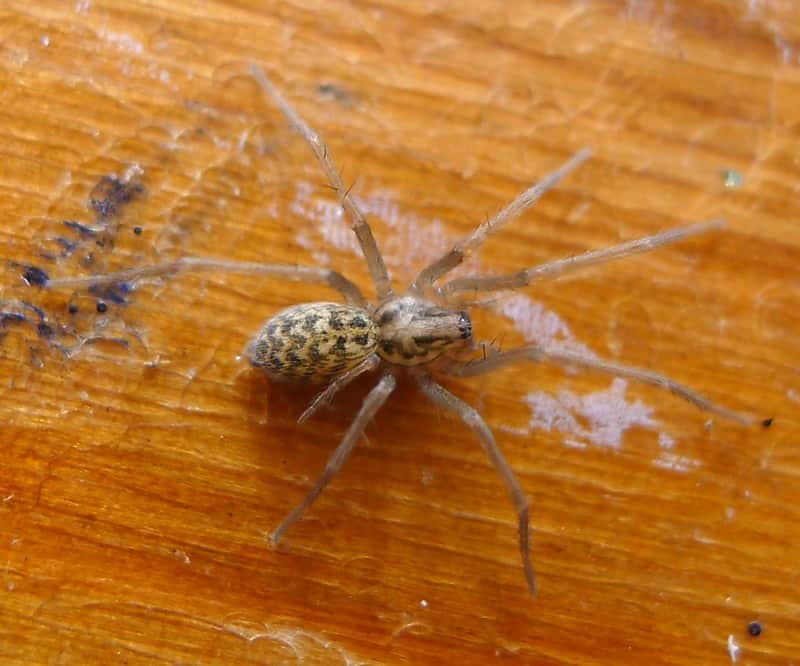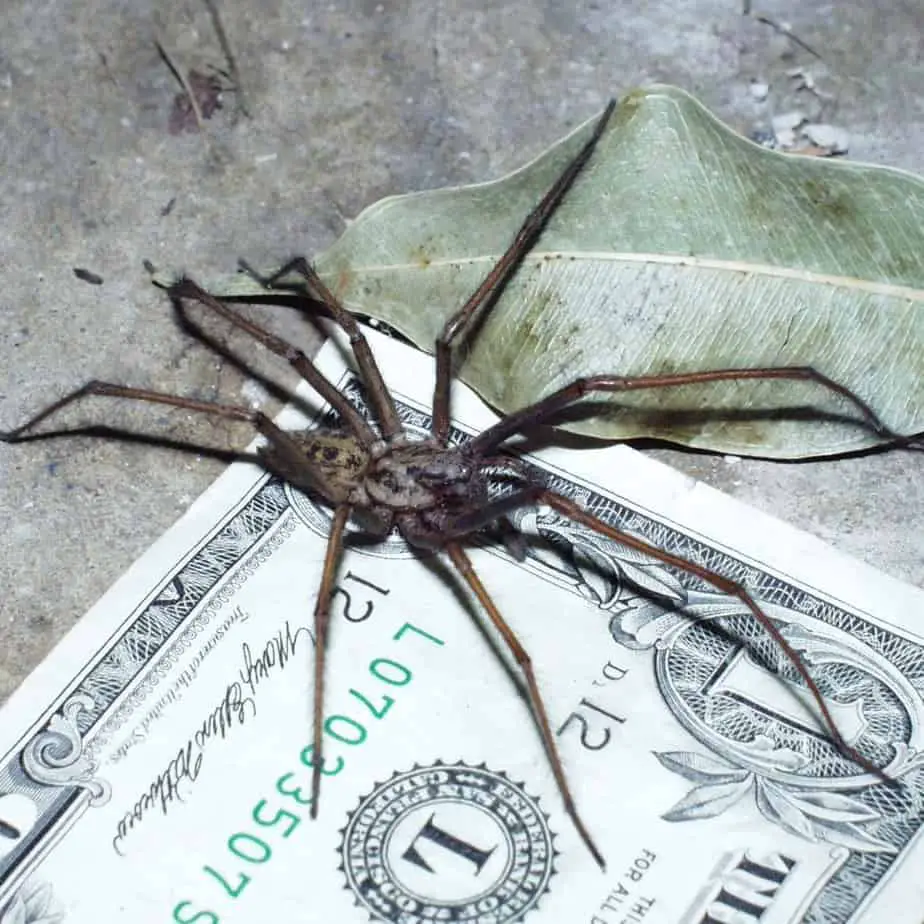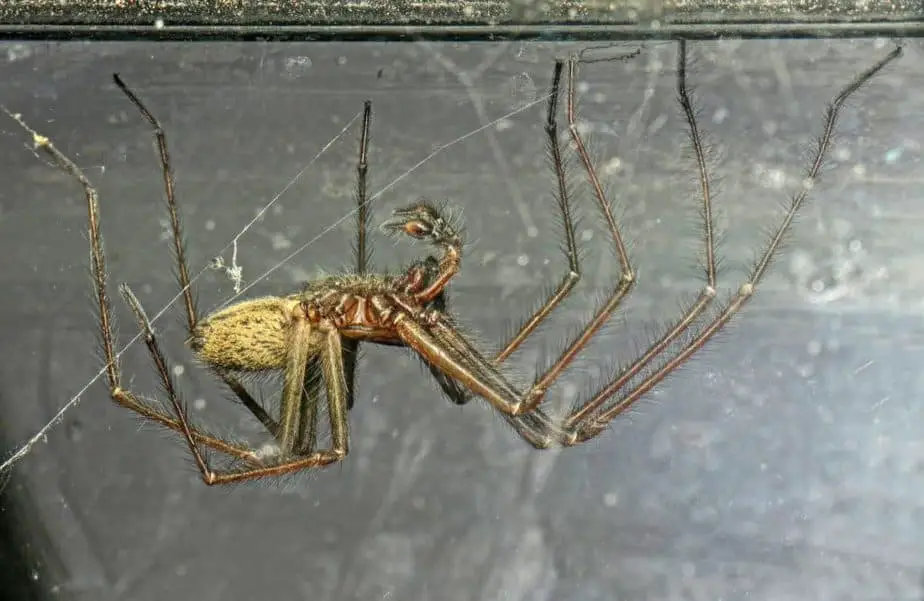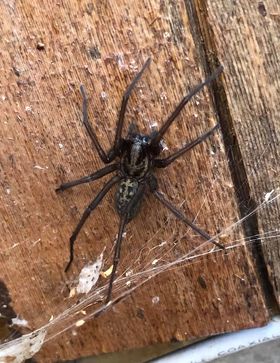As its name suggests, the giant house spider, Eratigena atrica, is one of the largest spiders found in Europe and the United States. The species is originally from Europe and was introduced to the Western United States over 100 years ago. It has now developed large populations in the Pacific Northwest and in the Great Lakes area. The giant house spider is the fastest spider in the world with recorded speeds of up to 1.7 ft/s (0.5 m/s).
Giant House Spider Description
The giant house spider is mainly brown with several characteristic markings. The cephalothorax (head) and the legs are a dark, reddish brown with a very dark brown oval shape on its cephalothorax.
The abdomen of the spider is relatively small and lighter, almost yellowish brown and gray, dark brown or black. The spider has a pattern on its abdomen, resembling three forward pointing arrows in a lighter color.

The giant house spider is often confused with the similar looking hobo spider (Eratigena agrestis) that is also common in the Pacific Northwest. The hobo spider has very similar markings but is generally smaller than the giant house spider and has shorter legs. The related grass spider (Agelenopsis sp.) is also often confused with the giant house spider. None of these species is considered dangerous for humans.
Size
While the body of the giant house spider reaches sizes comparable to other spiders, it has very long legs for a spider of its size. Male and female specimens look very similar with the female being slightly larger than the male. An adult female giant house spider can reach an average body size of 0.73 inch (18.5 mm) with an average leg span of 1.8 inches (45 mm). Some female specimens reach a leg span of over 3 inches (70 mm). The male grows to an average body size of 0.47-0.59 inches (12-15 mm)´and its average leg span is also slightly smaller than the female’s.

Web
The giant house spider is part of the funnel-weaver family. It builds funnel shaped webs in corners or edges inside houses or under rocks or small caves. The web itself is not stick. The spider lurks on the edge of the web and as soon as it feels any vibrations, it races towards the potential prey animal and subdues it with a bite.
Inside houses, the funnel-webs of giant house spiders are often found in corners on the ground as well as on the ceiling or hidden behind furniture. Since they don’t like to be disturbed by humans, they are most commonly seen in basements or darker areas of houses.
Bite
The giant house spider is not a medically significant spider. As almost all spiders, it possesses venom glands and given its size, also the possibility to penetrate human skin. However, the spider itself is very shy and its first instinct is to run (very fast) and hide when a larger being (humans or animals) approaches. Therefore, bites are very rare. In the few cases in which a giant house spider bites a human or a pet, the symptoms can include some local swelling and pain, comparable to a bee sting.

Geographic Range of the giant house spider in the United States and its habitat
The giant house spider was introduced to British Columbia, Canada, around 1900 and has since spread out along the U.S. West Coast. It is a very common spider in Washington State and Oregon. Independent populations have also been recorded around the Great Lakes in Wisconsin and Michigan.
The giant house spider prefers dry habitats. It is often found under rocks and in caves in a cool and dry environment. An average female spider lives for 2-3 years with some individuals living for up to six years. During the colder winter months, the spider often seeks refuge inside people’s homes. The fact that the spider is often found in or around homes has earned it its common name.

Eratigena atrica scientific classification
- Kingdom: Animalia
- Phylum: Arthropoda
- Subphylum: Chelicerata
- Class: Arachnida
- Order: Araneae
- Infraorder: Araneomorphae
- Family: Agelenidae
- Genus: Eratigena
- Species: Eratigena atrica
Until 2013, Eratigena atrica was classified as Tegeneria atrica. Some scholars also distinguish among three species of the giant house spider: Eratigena duellica, Eratigena saeva and Eratigena atrica. This overview considers only one species, Eratigena atrica.
References
- Taxon details: World Spider Catalogue
- Binomial name from: Koch, 1843
- https://www.naturespot.org.uk/species/giant-house-spider
- Oxford, Geoff S; Bolzern, Angelo (2018). “Molecules v. Morphology—is Eratigena atrica (Araneae: Agelenidae) One Species or Three?”. Arachnology. 17 (7): 337–357.

Hello,
I live in Alaska and my daughter finds these Spiders on our walls all the time. I just wanted to double check my guess of it being an Orb weaver type spider. It scares each time because it’s very similar to a brown recluse. Growing up in California we had Black Widows so I’ve always been cautious. My daughter however, likes to bring me these spiders alive and ask what they are 🤷♀️ I’m not a fan of it, especially since she’s 17 now lol
IMG_6091
This is a giant house spider (Eratigena atrica/duellica): https://usaspiders.com/eratigena-atrica-giant-house-spider/
Found this guy in my bathroom tonight, a little bit larger than a quarter. I live in Yakima, Washington.
Hello Mary, thanks for getting in touch! This is some type of funnel-weaver spider of the spider family Agelenidae. It could be a giant house spider (Eratigena atrica): https://usaspiders.com/eratigena-atrica-giant-house-spider/ or also a hobo spider (Eratigena agrestis): https://usaspiders.com/eratigena-agrestis-hobo-spider/
I am leaning towards giant house spider.
Despite the hobo spider’s bad reputation, both species are not medically significant and there is no proof that they can cause any harm to humans or pets.
I think it’s a Brown Recluse because they are highly dangerous there venom is really bad so I would be carful if you have kids around because they might Provoke the spider it will bite you but if they do get bitten go to the hospital soon as possible because these spider bites there Neurotoxin can kill dried tissue
Hello Maxx, this is definitely not a brown recluse. Recluse spiders are not found in Washington.
Also, the legs of recluse spiders are never banded like this funnel-weaver’s legs. Recluses don’t have visible spinnerets, no pattern on the abdomen and hardly any hairs on the legs.
Washington State
Hello Kandace, this is most definitely a giant house spider (Eratigena duellica/atrica): https://usaspiders.com/eratigena-atrica-giant-house-spider/
It’s not medically significant.
OMG… Is this outside, I’m scared of spiders and yet I find one in my restroom. I panicked and sprayed the s___ out of it!
Hi- We have seen quite a few of these in our home. We have an infant and two small dogs. I would prefer to let them live in peace-but just not inside my home. Is there any way we can control them and keep them out of our home without having to call an exterminator?
Hi Jill, peppermint oil is a great natural spider deterrent that can be safely used when children are around. You can find some more information about it here: https://usaspiders.com/peppermint-oil-spray-for-spiders/
I live In a suburb just outside Tacoma, Washington. Found this guy up on the wall in a corner just above my bookcase.
I don’t even want to try to grab it to take it outside because of how fast I think it will be!
Hi, I have had 2 of these spiders – I am sure they are giant house spiders with rusty brownish heads and black bodies with long slender legs in my house in Spokane, WA. From your pictures I am sure that’s what they are. I do like to return them – as quickly as possible! – to nature. I popped a bottle over them and slid a card under them. It took me a few minutes to get the card for the second one and it seemed to “play dead” and I thought, Oh, No, I smothered it. Then when I started pushing the card it quickly raced up the side of the jar. Do they do that? It seemed all crumpled and pathetic! 🙁 Is there any way to get them to move out???? No pictures – they are amazingly speedy and very much alive!!
Hi Evelyn, yes, spiders often play dead when a potential danger approaches. To get rid of them in a natural way, peppermint oil is a great spider deterrent. You can find some more information about it here: https://usaspiders.com/peppermint-oil-spray-for-spiders/
I Love Oregon So Very Much Because Of Its Beauty That I Traveled Clear Across The US From NC To Buy A Home There, But Since I Found Out About The Giant House Spider., I Absolutely Canot Live Here. Now Cause I Am A Major Arachnaphobic !
Found one crawling up my wall and caught it in a jar. It dropped off the wall the moment the jar touched it, but i caught them. Not sure if it’s male or female, but what should I feed it?
Yes, I am keeping it as a pet.
Hi Toxi, thanks for getting in touch! I can’t tell from the picture if it’s male or female. If you plan to keep it as a pet, make sure to add some plants and sticks to the enclosure where it can build a funnel-web. They eat various types of insects, ideally crickets. You can either feed them around one large cricket or three smaller crickets per week.
I all of a sudden saw this spider in the bedroom high up on the wall. I immediately tried to find out which spider it is and if it is dangerous. It’s a bit to high to capture and my daughter and I started freaking out. I am pretty sure that based on the other comments, that this is a Giant House Spider.
Hello Ruby, given the length of the legs and the overall appearance, I agree that this is most likely a male giant house spider. I can say with certainty that this is not one of the medically significant spiders found in the U.S. It can be safely relocated outside.
Found on a house wall in Colorado
Hello J, thanks for getting in touch! This is a giant house spider (Eratigena atrica/duellica): https://usaspiders.com/eratigena-atrica-giant-house-spider/
Saw this specimen outside of my apartment in Vancouver. Sorry the pic isn’t the best, but I was too scared to get any closer. I’m assuming that it’s a Giant House Spider. Hopefully my assumption is correct.
I live in Redmond, WA. Frequently I see giant house spiders in the fall. I found this one a week ago drinking spilled water on the kitchen floor. Today I found it dead in another room. It was not squished. How can I distinguish the sex of the spider. What is their natural cause of death. Thanks!
In the corner of Garage
Shelton, Washington, USA
On garage wall, Dec 1 2021
Body is about 3/4” long, dark brown, with darker brown or black secondary markings.
Hello SR, thanks for getting in touch! This is one mean looking spider 🙂 it’s a funnel web spider of the family Agelenidae. Most likely a giant house spider (Eratigena duellica/atrica): https://usaspiders.com/eratigena-atrica-giant-house-spider/
Found in Hubbard, Oregon (North of Salem by about 20 miles) Usually I can identify spiders fairly quickly, but this one has me a bit stumped. She has a slightly different body plan from what I’m used to with Wolf spiders, despite bearing strong resmeblance to them otherwise. Also, she was found indoors, in a web, among some old boxes while cleaning out my garage. I have her kept safely for the moment, and will hold on to her for a few days, so I can try to get more pictures if unable to identify her from this one. I’m leaning strongly towards some less common form of wolf spider than what I’ve seen before, but I decided to get other opinions before I take her out to the yard to release her.
Hello Ian, thanks for getting in touch! This is a giant house spider (Eratigena duellica).
Spider in Washington State
Hi Alissa, this is a giant house spider (Eratigena atrica/duellica): https://usaspiders.com/eratigena-atrica-giant-house-spider/
It’s not a medically significant spider.
Found in shed outside. Fairly large abdomen. 3/4” or so. Olympia, WA. April 22, 2022
Hi Jeff, this is a giant house spider (Eratigena atrica/duellica): https://usaspiders.com/eratigena-atrica-giant-house-spider/
I found this spider between my sheets and my comforter as I got ready for bed this evening. Scared the heck out of me. I might end up sleeping on the couch tonight. Seattle, WA, jun 9,2022
Hi Shelley, this is some type of funnel weaving spider (family Ageleindae). Most likely a gian house spider (Eratigena duellica): https://usaspiders.com/eratigena-atrica-giant-house-spider/
Found this in an empty plant pot outdoors in Tacoma, WA. Would prefer not to have to look at spider pictures to try to identify it myself. Any thoughts about what type it is? Thanks.
Hi Mel, this is a giant house spider (Eratigena duellica): https://usaspiders.com/eratigena-atrica-giant-house-spider/
I just wanted to say hi because I think spiders are awesome! Scary, but awesome. 🙂 Also, I’m doing a research project on spiders and I was wondering where I should go to study them?
Easter Washington State. Wolf spider?
Hello Daniel, this is a giant house spider (Eratigena sp.): https://usaspiders.com/eratigena-atrica-giant-house-spider/
This spider was found in Daviess County Kentucky on 7/16/23. Can you tell me what it is?
I have a Giant House spider that just recently appeared in my bedroom. She migrates from one upper corner to another every other day or so, and she has spun a web in two of the corners. I don’t really mind her being here, but I’m wondering if she’ll be able to survive without much food. Do these spiders go dormant? I’m thinking that she’d be better off being put outside, but it gets pretty cold and rainy here on the Oregon coast.